
Bulletin E2882
Understanding Wildfire Behavior in Michigan
DOWNLOAD
March 16, 2017 - Michigan State University Extension & D. Johnson
Introduction
Understanding how wildfires behave is important in protecting your rural home. The type of forest or field vegetation and the topography (slopes, hills) adjacent to your home will determine how vulnerable you are to wildfire. By giving attention to the topography while modifying the vegetation around your home, you can reduce the risk associated with wildfire.
Wildfire History in Michigan
Typically we think of states such as Colorado, Arizona and California as being prone to wildfires. But Michigan experiences an average of 8,000 to 10,000 wildfires each year. Most of these are small fires that do not make the evening news (Figure 1). But even these small fires can damage or destroy homes and property. Approximately 100 homes are lost or damaged each year by wildfires in Michigan. Wildfires occur in every county of the state. According to the Michigan Department of Natural Resources (MDNR), between 1950 and 1996, the MDNR and the U.S. Forest Service were involved in suppressing 46,100 wildfires that burned 390,000 acres of forest (Michigan State Police Emergency Management Division, 2001).
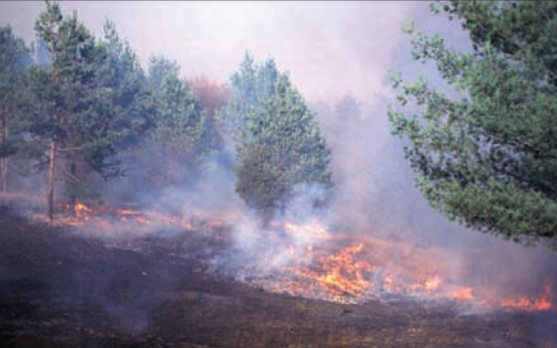
Wildfire Outbreaks
Wildfires can start in many ways, but about 98 percent of fires are caused by human activities. One-third of all wildfires are caused by people burning debris (household and yard waste, Figure 2). A moment’s inattention or an unexpected change in the weather can rapidly turn a debris fire into a wildfire. Once a wildfire starts, it may be impossible for a homeowner to put out.
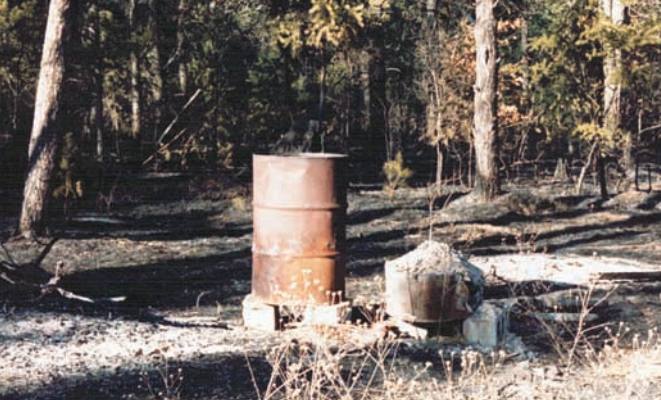
The Department of Natural Resources and local units of government use burn permits to communicate to homeowners when it is safe to burn and when it is not. They also provide safety information in the form of guidance on what can legally be burned to avoid undue air pollution, how to burn and what times of the day are safest.
Other human causes of fires include campfires, smoking, all-terrain vehicles and trains. Only about 2 percent of all wildfires have natural causes such as lightning.
Wildfire Behavior
Any fire requires oxygen, heat and fuel to burn, and a wildfire is no exception. Oxygen is abundant in the air and is never a limiting factor to a wildfire. Heat is provided by some ignition source and, once a wildfire has started, by the fire itself. Grass, brush, leaves and other vegetation provide fuel. Your home can also be fuel.
Large wildfires can move rapidly across the landscape, though not like a tidal wave, as is often depicted in the media. A wildfire moves from point to point across the ground as its requirements for heat and fuel are met. If an area contains no fuel, the fire will not go there. This is why wildland firefighters typically control wildfires by removing all vegetation (fuel) down to mineral soil to create a fuelbreak (Figure 3).
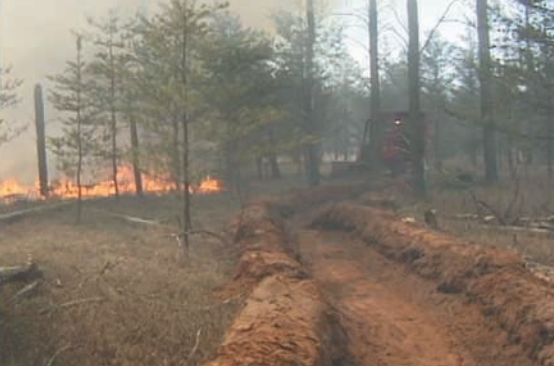
Wildfire Movement
Wildfires respond rapidly to changes in the moisture content of the fuel. Moisture in the fuel requires heat to evaporate. The more moisture there is in the fuel, the more heat is required for a fire to continue to burn and spread. When fuel is dry, a fire requires less heat to sustain itself. Small particles of fuel — such as dry grass, leaves and small twigs — experience the most rapid changes in moisture content and, on a high fire danger day, are the driest fuels. This means they typically burn the most rapidly. It is these fine fuels that carry a wildfire across the landscape. These small, fine fuels also burn up quite rapidly. Though a wildfire may last for many hours, it doesn’t last long in any one place — it burns past any given point in about one minute.
How Wildfires Ignite Homes
This quick movement across the ground is one key to protecting your home from wildfire. Wildfires transfer heat from the fire to your home in one of two ways: radiation and convection. Radiation is the heat you feel from a campfire or fireplace, while the sparks and embers you see rising from that campfire are lifted up by convection.
The amount of radiant heat a wildfire can transfer to your home depends on how far the fire is from the structure and how long it stays there. Research has shown that it is impossible for the radiant heat from a wildland fire to ignite a typical wood-sided home from more than 100 feet away. In fact, in simulations with actual fires and in case studies, homes as close as 33 feet from a wildfire have survived if the flames cannot actually touch the structure (Figure 4).
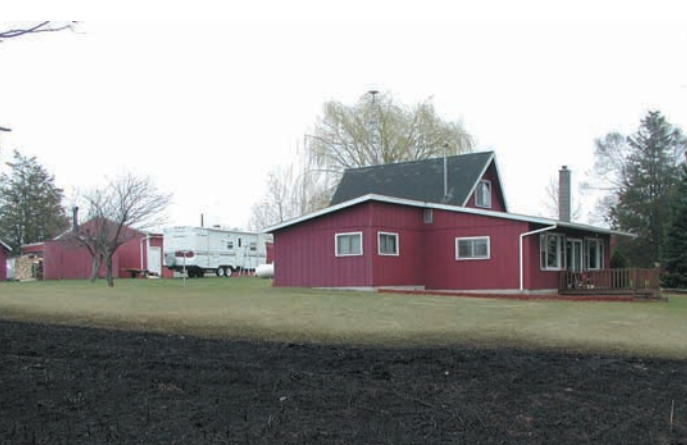
Firebrands and New Fire Starts
Wildfires and the heat they generate lift burning embers into the air and move them downwind, starting new fires when they land (Figure 5). When these embers (called firebrands) come from burning evergreen trees, they can move from 1 ⁄4 to 1 mile with the wind. A wildfire can generate a blizzard of these firebrands, starting scores of new fires and quickly overwhelming any fire control response.
It’s firebrands that pose the greatest danger to homes — far more than the flames themselves. These wind-driven embers can be blown under decks and porches, into cracks in the foundation, and into attics through faulty eave and roof vents. They can also land in combustible vegetation adjacent to the home and ignite it, and these flames then can ignite the home. This makes the area within 3 feet of the home the most important. Firebrands can land here and ignite a new fire at the home’s most vulnerable point.
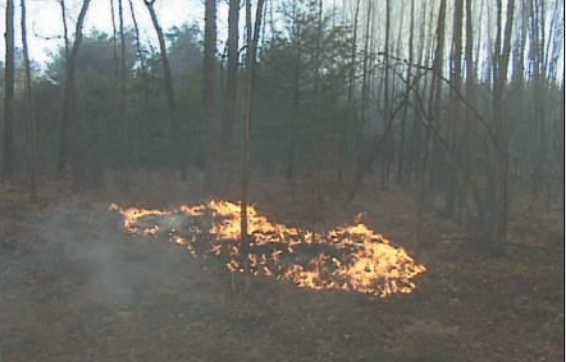
Hills and Slopes
Wildfires move more rapidly uphill than on level ground. This occurs because, as the fire moves uphill, the flames come closer to the unburned fuel in front of the fire (Figure 6). This heats and drives off the moisture from this fuel so it ignites quicker. Heat follows the slopes of the land and can act similar to the chimney on your fireplace. This intensifies the fire as it burns uphill.
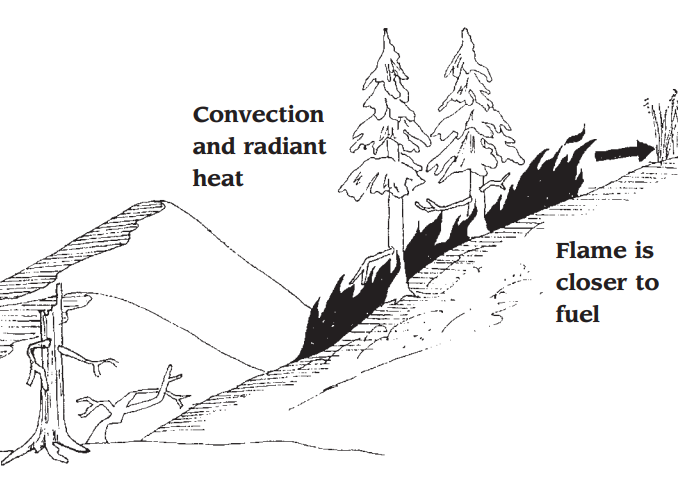
Homes built at the top of a tall slope are more vulnerable to wildfires because they are subjected to more heat for a longer period of time than they would have been if the land were level. Additional fuel clearance must be provided downhill from such homes to protect them from the additional heat.
Bringing it All Together
A basic understanding of fire behavior can help you protect your home from wildfire.
- Because wildfires don’t burn in one spot for more than about one minute, a 30-to 60-foot buffer between your home and large blocks of evergreen trees is sufficient to prevent radiant heat from igniting your home. Thinning the evergreens beyond your buffer will make the fire less intense so flames won’t touch your home.
- Because firebrands are such a danger to homes, time spent maintaining the 3-foot zone immediately adjacent to your home is very important. Keep leaves, dead grass and other debris out of this zone. Use fire-resistant landscape plants such as bunchberry (Cornus canadensis). Keep the areas underneath decks, porches and wood walkways clear of debris. Remember to treat any structure attached to your home (such as wooden walkways, attached garages, decks, porches, etc.) as part of the home when maintaining this zone.
- Because fires run rapidly uphill, additional distance is necessary between your home and evergreen trees on the downhill side. Provide an extra 30 feet on moderate slopes and more on steep slopes.
- Be aware of how easily a wildfire can start and that most wildfires occur close to homes.



 Print
Print Email
Email



